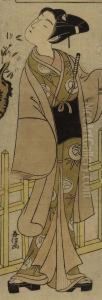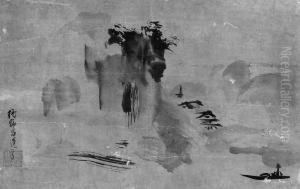Masunobu Paintings
Kano Masanobu (狩野 政信) was a pivotal figure in the history of Japanese painting, credited as the founder of the Kano school, which would become the most influential and enduring painting school in Japanese history. Born in 1466, Masanobu came of age during a period of significant social, political, and cultural transformation in Japan, a time when the country was transitioning from the medieval period into the early modern era. His works and stylistic developments laid the groundwork for successive generations of Kano artists, who would dominate Japanese painting for over 400 years.
Masanobu's painting style was characterized by its innovative fusion of Chinese painting techniques with indigenous Japanese aesthetic sensibilities. This was a reflection of the Muromachi period's (1336–1573) broader cultural fascination with Chinese art and literature, as well as the influence of Zen Buddhism. Masanobu was particularly adept at ink painting, a skill he elevated through his understanding of spatial composition and the subtle use of monochrome ink shades, which became hallmarks of Kano school artists.
Throughout his career, Masanobu served various shogunate and feudal lords, producing works that ranged from landscapes and portraits to narrative scrolls. His ability to adapt to the tastes and requirements of his patrons, while also infusing his works with a distinct personal style, helped establish the Kano school as a versatile and innovative artistic force. Masanobu's legacy is not only seen in the vast body of work he left behind but also in the institutionalization of his painting style, which became the official style for many of Japan's most important temples and palaces.
Masanobu's contributions to Japanese art were further solidified by his role as a teacher. He trained numerous students, including his son Kano Motonobu (1476–1559), who would go on to further develop and expand the Kano school, ensuring its dominance in Japanese painting through the Edo period (1603–1868). Masanobu's death in 1530 marked the end of an era but also the beginning of a lasting legacy, as the Kano school continued to influence Japanese art up to the modern period. His works are celebrated for their historical significance and their profound beauty, embodying the essence of Japanese aesthetics and the spirit of its cultural heritage.


